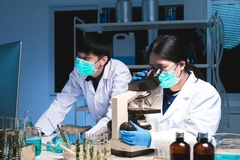Gelita reveals bioactive peptides stimulate collagen production “like lock and key”

28 Oct 2021 --- The collagen market continues to grow, whether targeting joint health in athletes, fine lines and wrinkles for beauty-seekers or stronger bones in older consumers. NutritionInsight sits down with Oliver Wolf, head of B2B marketing and communication at Gelita, to demystify the burgeoning ingredient.
Data from Innova Market Insights reports that collagen snack bars with a beauty positioning have increased 25% worldwide (Global, CAGR 2018-2021). Sports powders with collagen launches, meanwhile, have risen by 14% (Global, CAGR 2016-2021).
Amid category growth, a deeper understanding of how collagen works may help formulators create products that truly deliver benefits.
How collagen stimulates production
One common misconception is that ingested collagen forms the building blocks for collagen in the body.

“In fact, collagen fragments – known as bioactive collagen peptides (BCP) – stimulate the body to produce more collagen in a target organ,” explains Wolf.
“In joint cartilage, for example, the cells that build and degrade collagen are called chondrocytes. When these specialized cells detect degraded collagen in their environment, they ramp up collagen production to higher levels than normal to seek balance. This is what helps the cartilage recover faster.”
 Oliver Wolf, head of B2B marketing and communication at Gelita.For joint health applications, Gelita offers Fortigel, which has been hydrolyzed to activate chondrocytes. A similar mechanism occurs with other BCP that have amino acid compositions tailored to the application.
Oliver Wolf, head of B2B marketing and communication at Gelita.For joint health applications, Gelita offers Fortigel, which has been hydrolyzed to activate chondrocytes. A similar mechanism occurs with other BCP that have amino acid compositions tailored to the application.
“In the skin, for example, the target cells are fibroblasts. In the bones, these are called osteoblasts. The fractions are a little bit different, and therefore you have different molecules that stimulate them. It’s like a lock and key,” he says.
Working from the inside out
Wolf explains that for this process to work, collagen must be taken internally and enter into the bloodstream. Topical applications will not reach the dermis – only the epidermis, he adds.
He also notes that some collagen molecules are broken down into amino acids, but this is not completely done.
“The peptides that stay intact when passing through the intestine are exactly the ones that can stimulate cells to produce more collagen.”
Breaking down collagen
Bioactive peptides are formed by hydrolyzing native collagen into smaller molecules.
“Native collagen is a huge molecule,” continues Wolf. “It’s cross-linked and triple helixed. If you cut these molecules down to smaller molecules and open up the triple helix, you have linear amino acid chains, which are the BCP.”
He adds that the animal source is not relevant once the peptides have been broken down. “What’s important for BCP is their amino acid composition and their molecule size.”
 Bioactive collagen peptides must be ingested to impact the dermis layer of the skin.Clinical studies pillar of success
Bioactive collagen peptides must be ingested to impact the dermis layer of the skin.Clinical studies pillar of success
While demand for collagen shows no sign of slowing down, Wolf remains steadfast that clinical studies are essential.
“The clinical evidence is important to demonstrate both the mechanism of action and the effect it has on the body. We have studies that support both of these points.”
Gelita is continually working on new studies. The company also works with independent universities and research institutes, including the Collagen Research Institute in Kiel, Germany.
Clinical studies may also prove useful for supporting claims. Currently, in Europe, there are no approved claims so far for collagen as a food supplement ingredient.
There are some vitamin claims, however, that support the production of collagen, such as vitamin C. In Europe, vitamin C is able to claim it can contribute to the normal collagen formation for blood vessels, bones, cartilage, gums, skin and teeth.
Collagen has also recently been spotlighted for its role in the immune system.
The future of collagen
Today, Gelita sources its raw materials from byproducts of the meat industry. The skin and bones from cows and pigs are upcycled to produce both gelatin and collagen ingredients.
While conventional livestock agriculture is unlikely to disappear soon, moves toward more sustainable eating patterns and cellular agriculture have not gone unnoticed.
“If everyone in the world would stop eating meat, we would have a supply problem,” he muses.
Gelita is investing in biotechnology to produce next-generation collagen through fermentation.
“It’s not animal-based, nor is it plant-based. But it’s vegan. This is very new because collagen is animal-based protein per definition, and this biotech solution would change that.”
While it’s unclear when exactly this type of technology might be commercially available, Wolf affirms that it’s already possible. “It’s just a matter of scaling up the process,” he reveals.
Other players in the cellular collagen space include Jellatech, which raised US$2 million earlier this year to manufacture animal-free collagen and gelatin ingredients.
By Missy Green













